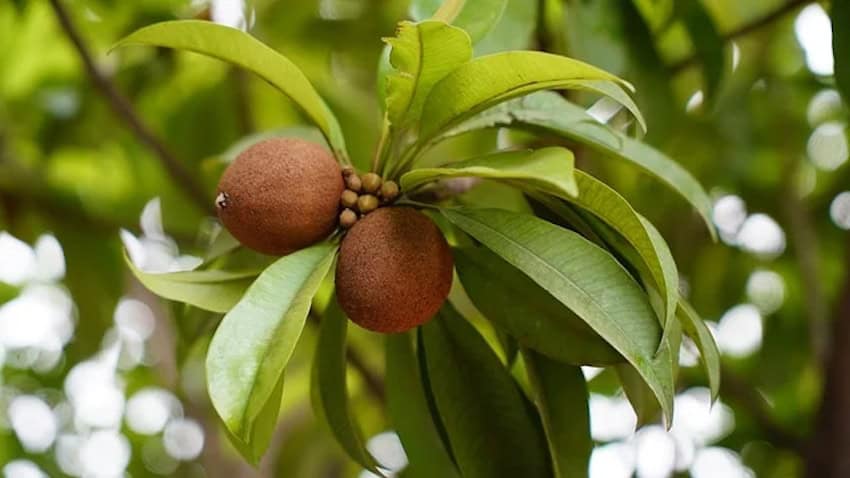Do you remember the article about tuna in which I mentioned that I struggled to understand how our brave ancestors could look at a tuna and think, “Now that looks incredibly delicious?” Well, chicozapote is one of those fruits that I’ve often thought our ancestors must have been really hungry to try.
Since I started writing for Mexico News Daily, I often think about you and what you might find odd, strange, suspicious, or even impossible to eat or drink. I have a feeling that chicozapote could be one of those fruits.
Chico… what?


The chicozapote is a fruit native to Mexico and Central America, where it has been cultivated for centuries by Mesoamerican cultures. This fruit grows on a highly useful tree, which not only produces the fruit but also yields a gummy resin. In Nahuatl, this resin is called “tzictli,” meaning gum. The Maya and the Aztecs used this gum to freshen their breath and clean their teeth.
As a fun fact for your next dinner party, Mexican President Antonio López de Santa Anna introduced the gum to Mr. Thomas Adams, who later industrialized it. Interestingly, in some regions, you can still find gum made from the resin of the chicozapote tree. Now, let’s return to the fruit itself.
Chicozapote
I have a confession to make: throughout my childhood, I missed out on the incredible flavor of chicozapote because I looked at the fruit and thought it would smell bad for weeks. The skin of chicozapote is similar in color and texture to a kiwi, but its pulp is completely different. It can be orange or brown and has a soft, fleshy texture. It also contains easily removable black seeds, which contributed to my initial hesitation.
To my surprise, the flavor of the pulp is delightful; it’s hard to believe that something with brown pulp could be so sweet and flavorful. For those interested in nutritional facts, this little fruit is packed with fiber, vitamin C, and antioxidants, so don’t hesitate to incorporate it into your diet.
What does chicozapote taste like and how do you eat it?
Chicozapote has a very sweet flavor, akin to brown sugar, honey, or caramel. I recommend cutting the fruit in half and scooping out the pulp with a spoon.
How do I know when it’s ready to eat?
If the skin has green or yellowish spots, the fruit is not ripe yet. When the skin turns completely brown, it is ready to eat. Another indication of ripeness is its softness; if it feels soft to the touch, similar to an avocado, then it’s at its peak.
If you find the experience of eating a chicozapote overwhelming, here are some ideas to get you started:
- Smoothies and Shakes: The chicozapote’s soft texture makes it an excellent addition to smoothies or shakes. You can combine it with other tropical fruits like mango, pineapple, or orange for a refreshing and energizing breakfast.
- Ice Creams and Sorbets: Thanks to its natural sweetness, chicozapote is a wonderful ingredient for making ice creams and sorbets. One of my favorites is chicozapote-orange sorbet (more on that later). The acidity of the orange beautifully balances out the sweetness of the chicozapote, creating a perfect combination.
- Traditional Desserts: In some regions of Mexico, chicozapote sweet is a classic treat. The pulp is slowly cooked with sugar and cinnamon until it achieves a thick consistency. This sweet can be enjoyed on its own or served alongside fresh cheeses.
- Jams and Preserves: The fruit is slowly cooked with a bit of extra sugar and used as a spread for bread, cookies, or even savory dishes.
- Meat Sauces: This is for gourmet enthusiasts. Its sweet, rich flavor pairs beautifully with grilled or smoked meats, adding a caramelized touch to the dishes.
The Recipe that Introduced Me to the Chicozapote Universe: Orange-Chicozapote Sorbet


Ingredients:
– 2 ripe chicozapotes
– 1 cup of fresh orange juice
– 1 tbs of lemon juice
– 1 cup of water
– Zest from 1 orange (optional, for a more intense flavor)
– Honey (to taste)
Instructions:
- Prepare the chicozapotes: Peel the chicozapotes and remove the seeds. Place the pulp in a food processor or blender to create a smooth mixture.
- Mix the liquids: In a separate container, combine the orange juice, lemon juice, and water. If you choose to add sugar or honey, stir until fully incorporated.
- Combine the mixtures: Add the chicozapote pulp to the juice mixture and stir well until everything is fully combined. For a more intense orange flavor add orange zest.
- Freeze: Pour the mixture into a container and let it rest in the freezer for 1-2 hours.
- Blend again: After an hour, return the mixture to the food processor or blender to achieve a creamy texture. You can repeat this process as needed until the sorbet is completely frozen and smooth.
- Serve: Allow the sorbet to sit out for a few minutes before serving to soften slightly. Serve in chilled glasses and garnish with a bit of orange zest or a fresh orange slice, if desired.
Enjoy your sorbet, and remember: don’t judge a fruit by the color of its pulp!
María Meléndez is a Mexico City food blogger and influencer.

